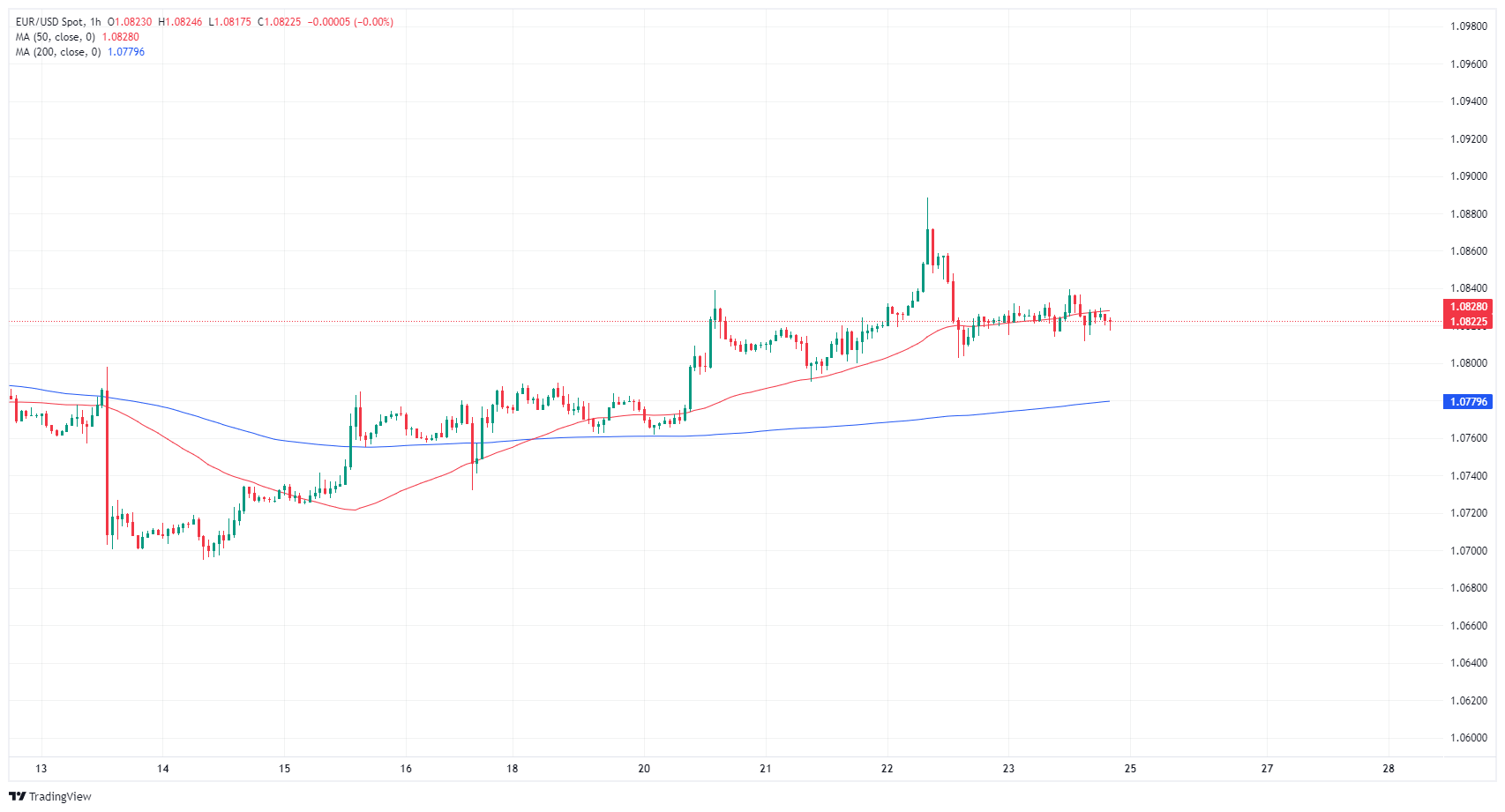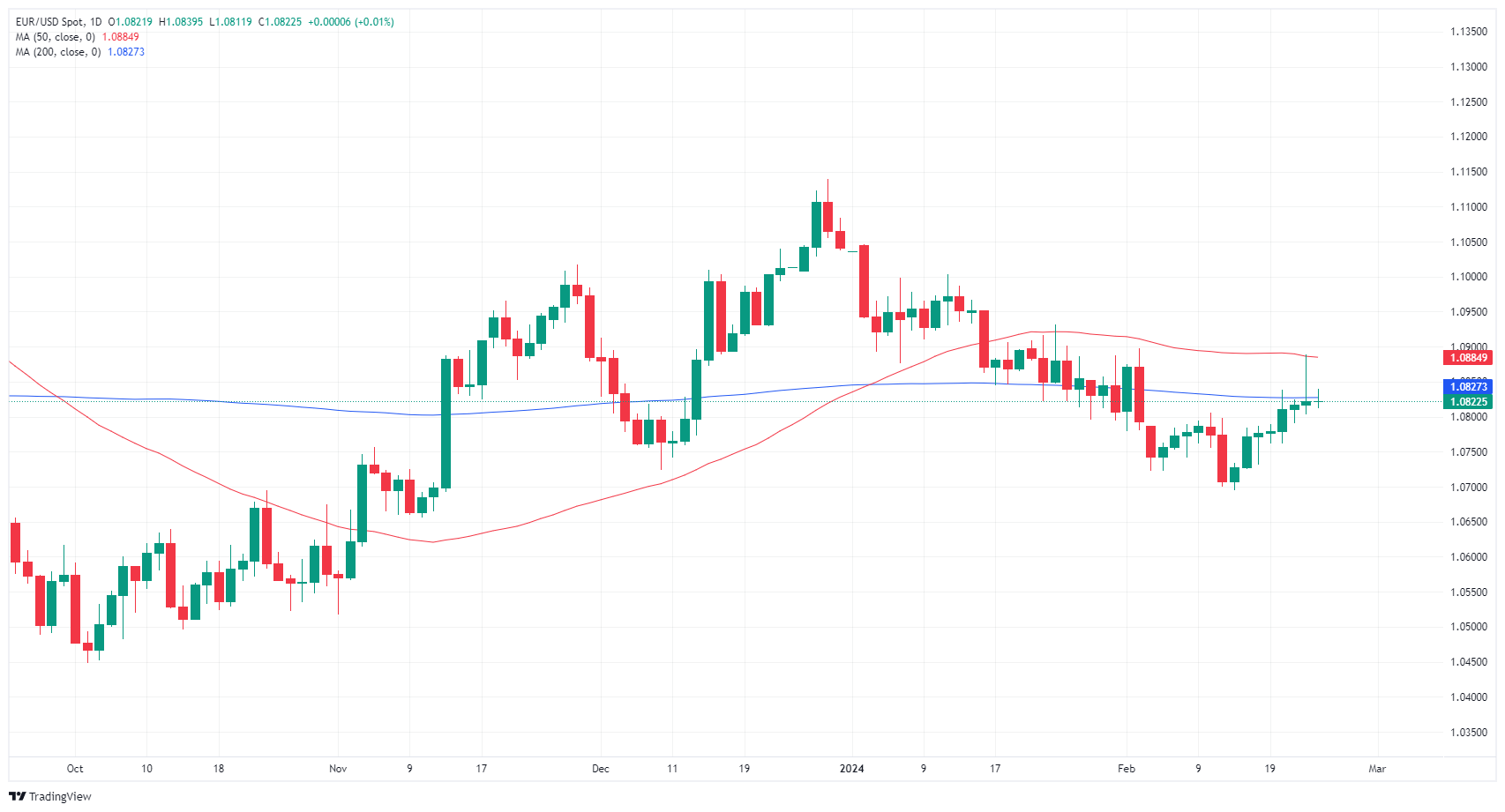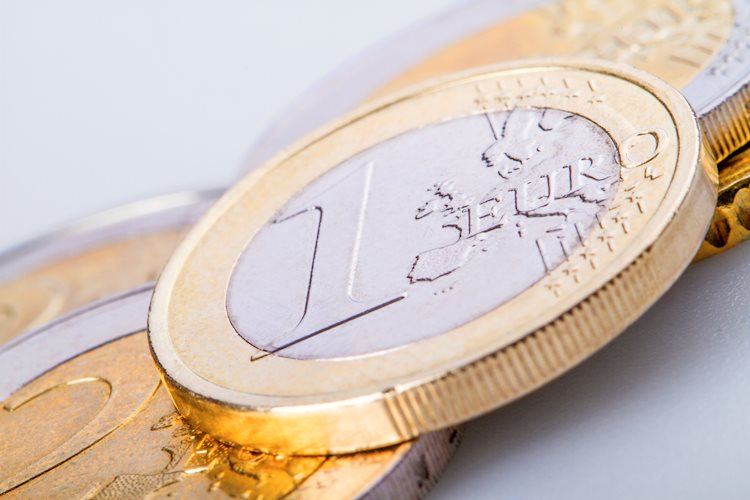- EUR/USD continues to cycle north of 1.0800.
- European data confirms preliminary prints.
- Investors will have to wait until midweek for meaningful data.
EUR/USD cycled on Friday, stuck in a near-term range between 1.0840 and 1.0810 as markets settle in for the weekend and gear up for the long wait for significant data. Fresh figure prints aren’t due until the back half of next week, and the pair is hanging onto the top half of the week’s chart action.
Next week sees US Gross Domestic Product (GDP) on Wednesday, followed by German Retail Sales and German Consumer Price Index (CPI) figures on Thursday. Thursday also sees US Personal Consumption Expenditure figures (PCE). Pan-European Harmonized Index of Consumer Prices (HICP) rounds out next week alongside US ISM Purchasing Manager Index (PMI) numbers.
Daily digest market movers: thin action for EUR/USD leaves pair strung along the middle
- Friday pulls into the midrange, EUR/USD continues to grind it out near 1.0820.
Germany’s final GDP print for the fourth quarter revealed nothing new, confirmed the preliminary prints.
Final German Q4 GDP declined -0.3% QoQ, -0.4% compared to the same quarter last year.
German IFO Expectations for February improved more than expected, printing at 84.1 versus the forecast for 84.0 and beating the previous print of 83.5.
Several European Central Bank (ECB) policymakers hit the newswires as Europe’s Eurogroup meeting gets underway alongside day two of EcoFin Meetings. - ECB coverage: policymakers scramble for the microphone on Friday.
- Next Thursday’s US PCE Price Index figures for January will be a key dataprint as investors seek signs the Federal Reserve (Fed) will get pushed into rate cuts sooner rather than later.
US MoM January PCE Price Index forecast to tick higher to 0.3% from 0.2%.
Core PCE for the same period is expected to accelerate to 0.4% from 0.2%.
Euro price this week
The table below shows the percentage change of Euro (EUR) against listed major currencies this week. Euro was the strongest against the Japanese Yen.
| USD | EUR | GBP | CAD | AUD | JPY | NZD | CHF | |
| USD | -0.45% | -0.54% | 0.06% | -0.25% | 0.26% | -1.00% | 0.00% | |
| EUR | 0.45% | -0.09% | 0.51% | 0.21% | 0.71% | -0.54% | 0.45% | |
| GBP | 0.54% | 0.09% | 0.60% | 0.27% | 0.80% | -0.45% | 0.54% | |
| CAD | -0.06% | -0.52% | -0.60% | -0.41% | 0.21% | -1.11% | -0.03% | |
| AUD | 0.26% | -0.19% | -0.26% | 0.34% | 0.55% | -0.73% | 0.28% | |
| JPY | -0.25% | -0.72% | -0.78% | -0.21% | -0.51% | -1.26% | -0.26% | |
| NZD | 1.02% | 0.57% | 0.48% | 1.08% | 0.77% | 1.27% | 1.02% | |
| CHF | 0.01% | -0.41% | -0.53% | 0.18% | -0.28% | 0.22% | -0.98% |
The heat map shows percentage changes of major currencies against each other. The base currency is picked from the left column, while the quote currency is picked from the top row. For example, if you pick the Euro from the left column and move along the horizontal line to the Japanese Yen, the percentage change displayed in the box will represent EUR (base)/JPY (quote).
Technical analysis: EUR/USD remains pinned to 1.0820
EUR/USD continues to churn the waters just above the 1.0800 handle as the pair remains bolstered above the 200-hour Simple Moving Average (SMA) near 1.0780. The pair managed a bullish climb into a near-term high of 1.0888 in the midweek before getting pushed back to familiar levels.
Daily candlesticks reveal the EUR/USD remains hampered by the 200-day Simple Moving Average (SMA) at 1.0827, and despite being on pace to close for an eighth consecutive trading day on Friday, EUR/USD remains on the low side of key technical levels. The pair is still down around 2.8% from late December’s peak bids at 1.1140.
EUR/USD hourly chart
EUR/USD daily chart
Euro FAQs
The Euro is the currency for the 20 European Union countries that belong to the Eurozone. It is the second most heavily traded currency in the world behind the US Dollar. In 2022, it accounted for 31% of all foreign exchange transactions, with an average daily turnover of over $2.2 trillion a day.
EUR/USD is the most heavily traded currency pair in the world, accounting for an estimated 30% off all transactions, followed by EUR/JPY (4%), EUR/GBP (3%) and EUR/AUD (2%).
The European Central Bank (ECB) in Frankfurt, Germany, is the reserve bank for the Eurozone. The ECB sets interest rates and manages monetary policy.
The ECB’s primary mandate is to maintain price stability, which means either controlling inflation or stimulating growth. Its primary tool is the raising or lowering of interest rates. Relatively high interest rates – or the expectation of higher rates – will usually benefit the Euro and vice versa.
The ECB Governing Council makes monetary policy decisions at meetings held eight times a year. Decisions are made by heads of the Eurozone national banks and six permanent members, including the President of the ECB, Christine Lagarde.
Eurozone inflation data, measured by the Harmonized Index of Consumer Prices (HICP), is an important econometric for the Euro. If inflation rises more than expected, especially if above the ECB’s 2% target, it obliges the ECB to raise interest rates to bring it back under control.
Relatively high interest rates compared to its counterparts will usually benefit the Euro, as it makes the region more attractive as a place for global investors to park their money.
Data releases gauge the health of the economy and can impact on the Euro. Indicators such as GDP, Manufacturing and Services PMIs, employment, and consumer sentiment surveys can all influence the direction of the single currency.
A strong economy is good for the Euro. Not only does it attract more foreign investment but it may encourage the ECB to put up interest rates, which will directly strengthen the Euro. Otherwise, if economic data is weak, the Euro is likely to fall.
Economic data for the four largest economies in the euro area (Germany, France, Italy and Spain) are especially significant, as they account for 75% of the Eurozone’s economy.
Another significant data release for the Euro is the Trade Balance. This indicator measures the difference between what a country earns from its exports and what it spends on imports over a given period.
If a country produces highly sought after exports then its currency will gain in value purely from the extra demand created from foreign buyers seeking to purchase these goods. Therefore, a positive net Trade Balance strengthens a currency and vice versa for a negative balance.
